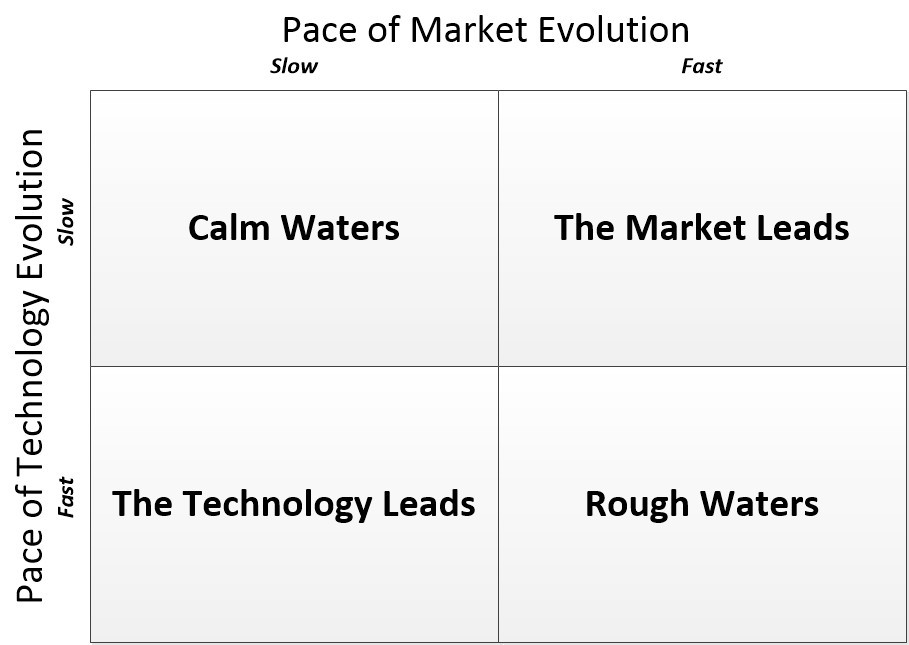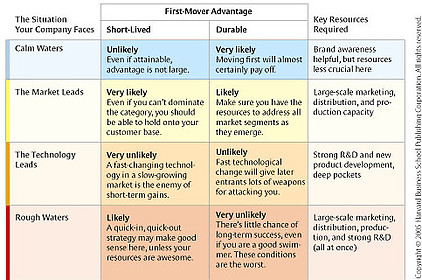Are you are working on a situation at the initial and growth stages of a business? This post explores the opportunities, risks, and impacts of being the ‘first mover’ during the growth stage of a business. The decision to be a first mover is not clear cut, and it can just as often be advantageous to be a late mover.
There are many risks, whether first mover or late mover, but they can be understood and managed proactively if you understand first mover advantage theory. Let’s begin by exploring this often misunderstood framework.
What Is First Mover Advantage Theory?
 Is being the first mover really a reliable advantage? The reality is that it is situational and advantages and disadvantages of being the first mover are probably close to equal. Your situation needs to be analyzed carefully.
Is being the first mover really a reliable advantage? The reality is that it is situational and advantages and disadvantages of being the first mover are probably close to equal. Your situation needs to be analyzed carefully.
This idea is reinforced in the Harvard Business Review article “The Half-Truth of First-Mover Advantage” by Fernando F. Suarez and Gianvito Lanzolla, which states, “First-mover status can confer advantages, but it does not do so categorically. Much depends on the circumstances.”
Let’s begin by investigating just what those circumstances might be by referring to the chart at right. When looking at the business environment, key considerations related to first mover advantage include the pace of market evolution and the pace of technology evolution.
Let’s take a look at the four quadrants of the chart and how combinations of Fast and slow pace of market evolution and technology evolution effect the likelihood of achieving First Mover Advantage, or FMA.
- Calm Waters – This is the area on the chart where there is a slow pace of both technology and market evolution. A business that can gain traction as first mover in such a situation can build substantial advantages that are difficult to overcome. The stable market and technology work to the advantage of the first mover who, once entrenched as the market leader, is difficult to jar loose by a challenger, who needs to battle that market and technology inertia.
- The Market Leads – Where the pace of market change is rapid, but the pace of technology change is low, the winners will be those who have strong marketing advantages, either via position or other capabilities. A company that is tech savvy but not strong in marketing will have difficulty as a first mover, and even if they have some early success, they will be vulnerable to challenges from a more market savvy competitor.
- Technology Leads – Here the pace of market change is slow, but the technology is evolving rapidly. A firm must have strong technology capabilities to gain first mover advantage. A tech savvy company has a good chance to gain and sustain first mover advantage. If a market savvy company gains an initial first mover advantage, they will be vulnerable to challenges from more tech savvy competitors.
- Rough Waters – Both technology and market are changing rapidly, so it will be an extra challenge to gain first mover advantage. Any company that wants to gain a first mover advantage must have strengths in both technology and market, and such a company would also potentially be capable of overcoming a first mover who gained an early advantage but is not as strong at one or the other, technology or market capability.
The key to understanding this is to think about how a first mover can react to a competitive challenge related to either the market or technology. If the first mover is in a good position to marshall its resources – either related to market or technology strength – to defend its position, then the first mover has the advantage. If the first mover finds it difficult to defend its market or technology position from competitive challenges, the late mover has the advantage.
FMA can also be hard to define because it brings questions such as whether first mover means ‘first to begin to research and develop a product’ or ‘first to enter a new product into the market’. There are other complications, such as how much time has passed since the pioneer’s first release, and complexities such as being an early follower, late follower, or differentiated follower.
There are also different ways to measure first-mover advantage, such as by profit, market share, or even probability of survival. There is also the possibility to measure the magnitude and duration of first mover advantages.
Personality and culture of companies are also important factors to consider. Some firms are oriented to be pioneers, while others are more suited to follow, learn, and improve upon what a first mover has developed. In that sense, first mover advantage can refer to the first ‘significant’ company to move into a market.
The way an industry is structured can also have an influence on the choice of whether to be a first mover or to follow. An industry might provide a first mover with near-monopoly status and high margins, while another industry might provide late movers the opportunity to compete more robustly against early entrants, or even acquire them.
In short, being a first mover only makes sense if the rewards justify the risks.
Advantages of Being the First Mover
The following is a summary of potential first mover advantages:
- Strong brand recognition and customer loyalty – A first mover may be able to establish this before competitors enter the arena. While building the brand, the first mover will also have additional time to perfect its product or service while building relationships with customers.
- Economies of scale – The first mover has more time to build cost-efficient ways of producing or delivering a product. This is made possible through gaining power through control of key resources, such as strategic locations, contracts with key suppliers, or hiring of uniquely talented employees. The first mover can also establish the market price for the new item, in part based on anticipated volumes.
- Switching costs – A first mover can establish a product as the industry standard, thus building switching costs for early consumers.
Using all three of these major advantages, a first mover can potentially establish sufficient market share and a solid enough customer base to maintain the majority of the market indefinitely.
Advantages of Being a Late Mover
Depending upon the characteristics of the business – a SWOT analysis can help determine whether it might fare as a first mover. It will also depend upon the characteristics of the target opportunity – in terms of pace of technology and market evolution, as the chart at the top shows.
Advantages to the late mover are somewhat like first mover in reverse:
- Avoid up front costs – The costs to imitate – to copy and improve – are likely much lower than the costs to innovate, as long as early advantages are not impossible to overcome. In addition, the late mover can avoid the heavy investments to educate and persuade consumers to try a new product.
- Wait until things stabilize – A larger, better postured – but probably less agile – competitor can avoid the risk of failure to produce a product that aligns with consumer interests and learn from the mistakes made by the first mover. They can gain an understanding of the business model(s) that can work. They can avoid much of the risk associated with developing a new technology and creating a new market for it.
- Fits company profile – A ‘follower’ company can take the opportunity to follow industry standards – and then leverage their strengths in other areas on top of that. It may be advantageous to follow, depending on the potential magnitude and duration of first mover advantage that it might experience if it moved first. A late mover can also avoid getting locked into a specific set of fixed assets, organization conflicts with existing product lines, and contending with organizational inflexibility when agility is needed.
The advantages of not being the first mover also depend very much on the profile of the opportunity – where it fits as to speed of technology and market evolution. In his classic book, “Crossing the Chasm: Marketing and Selling Disruptive Products to Mainstream Customers,” Geoffrey Moore covers many of the challenges of being a first mover or late mover, and models how it is likely to play out.
—————————————-
I recommend these PM templates (paid link):
—————————————-
Project Risks and First Mover Advantage Theory
 Referring back to the Harvard Business Review article “The Half-Truth of First-Mover Advantage,” the diagram to the right depicts a method for beginning to weigh the risks associated with moving first.
Referring back to the Harvard Business Review article “The Half-Truth of First-Mover Advantage,” the diagram to the right depicts a method for beginning to weigh the risks associated with moving first.
There are three things to recognize and track in the process of identifying and managing the strategic risks with which your project or program will be associated.
- Situation – Is your situation or opportunity, which your project or program is supporting, characterized as Calm Waters, The Market Leads, The Technology Leads, or Rough Waters?
- First mover advantage – Will first mover advantage be short-lived or more durable?
- Key Resources Required – What are the key resources that are required to support getting your company into a strategically advantaged position?
This is a starting point for identifying risk management metrics. You will need metrics that closely track the company’s evolving competitive position. You will need more refined metrics specific to your program’s contribution to that position. And you will need metrics for tracking the resource needs and usage as required.
Speed of execution is also critical, so processes for managing schedule risk will also be important to put in place. Mapping milestones to actual observations of technology and market development will make sense.
You can start with this perspective, whether managing risk as a first mover, late mover, or even as a purchaser of products or services from an arena consisting of first movers and late movers.
Actions for Project and Program Managers
First mover advantage only comes into play in the initial stages – Start-up and Growth – of the business development life cycle. If it is, it can be helpful to use first mover advantage theory to analyze and plan your way ahead.
If the business your project or program is supporting is in the initial stages, you need some short cuts to gain perspective on the type of situation in your environment. Identifying the pace of technology and market change can give you some initial perspective. Understanding the options for your company as first mover and late mover is another consideration.
Ask yourself if your business is best suited as a first mover or late mover, and if that matches the strategy in play. If not, you need to raise your hand and voice concerns! If it is, you need to plan and execute in alignment with that strategy.
Finally, you need to manage risk by tracking closely to strategic metrics appropriate for the market and technology environments in which you are operating. Schedule risk also must be watched closely, as the timing of hitting key milestones for strategic position achievements is critical.
—————————————-
I recommend these strategy resources (paid link):
—————————————-

